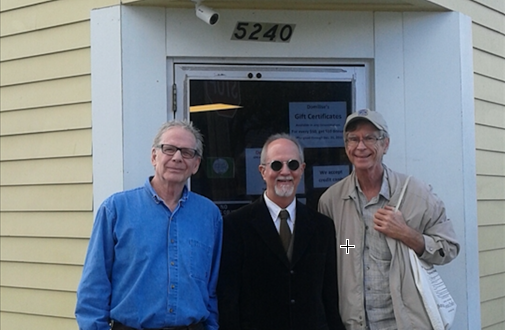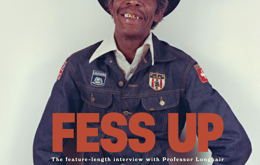No city on earth is so deeply bonded to its music as `the cradle of jazz,’ New Orleans. Louis Armstrong’s likeness looms large at his namesake airport, greeting arrivals alongside panels celebrating lesser-known jazz pioneers while a Dixieland soundtrack throbs from speakers overhead. The St. Pierre Hotel’s walls are a mute brass band of antique instruments mounted like trophy fish, reputedly blown in the bygone by Satchmo, Kid Ory, and other founding jazz fathers. The streets of the French Quarter pulse daily to parading brass bands, tipsy tourists in tow, festooned with Mardi Gras beads, Go Cups in hand.
Tulane University is a world apart from the boozy bonhomie of Bourbon Street. This academic oasis is nonetheless friend to the raucous musical energies that define New Orleans. In Jones Hall, a non-descript building housing several archives, lives the William Ransom Hogan Jazz Archive, one of the world’s major collections of music, materials and memorabilia related to jazz and kindred sounds. What’s there isn’t just jazz– a huge sheet music collections holds much that pre-dates it by decades. “New Orleans was a big music publishing center,” says archivist Lynn Abbott. “We have sheet music published here going all the way back to the 1850s.” There are also hundreds of piano rolls from the collection of Western Swing and Dixieland pianist Knocky Parker. Recorded `jass’ (once a rude word) commenced in 1917 with New Orleans’ Original Dixieland Jazz Band. The Hogan Archive harbors the vast collection of ODJB leader/cornetist and “Tiger Rag” composer Nick LaRocca, who was adamant about his band’s status as light bearers at jazz’s genesis. “He kept tons of scrap books from the beginning,” says Abbott, “and his marginalia is incredible! Next to a newspaper clipping he’d write something saying how the clip proved he and his band were first. Someone could write a dissertation based on LaRocca’s marginalia.”
Dissertation writers frequently turn up at the Hogan Jazz Archive, as do distinguished scholars from abroad. All of us can access it (to a degree) online at jazz.tulane.edu. The Archive may be far from the madding New Orleans crowd, but the public finds it anyway. “I’ll get calls from ladies saying, `My late husband left this Billy Eckstine album, that’s got to be worth a hundred bucks, right?’” says curator Bruce Boyd Raeburn. “I’ll look it up on Amazon and find it’s worth maybe nine bucks.” But the curator of one of the world’s leading music archives is only a phone call away and apparently not above appraising your musical flotsam for you. Raeburn looks the part of the dapper academic but once played drums for mad genius pianist James Booker: he knows New Orleans music from the street level as well as from the Ivory Tower. He’s the son of respected `40s big band leader/saxophonist Boyd Raeburn, so you could say he has jazz genes.
Archivist Lynn Abbott lacks that jazz pedigree, hailing from Virginia and admitting to a lingering love of bluegrass, particularly Mac Wiseman (“He means it,” Lynn says of Mac’s singing). But on the day I visit he’s focused on a major New Orleans legacy that’s in the process of being archived, the 78 collection of pioneering black DJ Vernon Winslow, AKA Dr. Daddy-O. Winslow was a presence on Crescent City airwaves for decades, appearing on various radio stations and amassing a huge record collection. “A lot of the vinyl was sold piecemeal after he passed in `93,” Lynn says, “but no one wanted the 78s.” The more than 3,000 pieces of orphaned shellac passed through a couple of hands before wending their way to the Archive. “They’d been stacked flat,” says Lynn, “and a lot came to us warped or broken.” In the Jones Hall storage basement dwells a box of some 200 78s from Winslow’s collection that were DOA: some were thoroughly smashed, others chipped just enough to render them unplayable. Lynn meticulously catalogs the survivors: they are arranged by label and now live in sturdy tan 78 sleeves and stand upright in solid gray-green boxes, enough of them to devour all the real estate on two long tables. (That’s not their final destination, just their load-in zone.) Lynn pops the top off a box bearing a cache of Aristocrats. Aristocrat was the label that begat Chess, the record home of such classic Chicago blues artists as Muddy Waters and Howlin’ Wolf and such first-generation rockers as Bo Diddley and Chuck Berry. “Now here’s an interesting title,” he says, extracting from the box a treasure credited to “Doc” Jo Jo Adams with Tom Archia’s All Stars and entitled “Cabbage Head, Part 1 & Part 2.” “I wonder if it’s a variant of this old English song, `Our Goodman,’” says Lynn. “There were a lot of African-American variants.” There’s only one way to find out. Lynn makes a beeline for the Archive’s 78 player. Here’s the payoff for dreary hours of tedious grunt work, cataloging endless label info (artist, title, songwriter, etc.). We’re about to experience the only thing that justifies the tedious archival enterprise: the music. There’s a moment of anticipation before the needle connects with the fast-spinning grooves and an unspoken awareness that we’ll soon hear a recording from 1948 which has likely gone unplayed long enough to collect Social Security. What pours from the speakers is late-`40s R&B, horns framing a `blues shouter’ who comes home `high as I could be,’ only to find his wife in bed with another man. Her artful dodges of his queries about this state of affairs are the crux of the song.
“Thursday night I got high again, just as high as I could be,
Well then I saw a head layin’ in the bed where my head is supposed to be!
I said, `Wake up my wife, my beautiful wife, wake up and answer me:
Tell me whose ol’ head is that in the bed
Where my head’s `sposed to be?’
She said, `Be `shamed, you fool, you drunken ol’ fool,
Now honey, can’t you see? That ain’t nothin’ but a cabbage head
that your gran’ma gave to me.’
I said, `I traveled this world for many miles and I hope to travel some more,
but I’ll be dogged if I ever saw a cabbage head with hair growin’ on it before.’”
Listening, Lynn smiles. “It’s a very faithful variant,” he says of a song little changed lyrically from its old English original but musically retooled for late `40s tavern jukebox play. “Cabbage Head Part 1” ends amidst a flurry of hiss as the tone arm skates toward the label. “Should I turn it over?” Lynn asks. It’s a rhetorical question. Upon hearing the flip it becomes plain Dr. Daddy-O likely never played “Cabbage Head Part II” on the air: the drunken cuckold’s inquiries become increasingly anatomical.
“Saturday night I got paid, got just as high as I could be,
Well, I saw a thing in the thing where my thing’s supposed to be.
I said, `Wake up my wife, my beautiful wife, wake up and answer me:
Tell whose ol’ thing is that in that thing
Where my thing is supposed to be?’
`Be `shamed, you fool, you drunken ol’ fool, when honey, can’t you see?
That ain’t nothin’ but a rollin’ pin that your gran’pa made for me.’
I said, `I traveled this world for many miles, and I hope to travel some more,
but I’ll be dogged if I ever saw a rollin’ pin with a `ba-be-o-reenie’ before.’”
“The Cabbage Head” by Sundry names journeyed from boozy, bawdy ole England to America long ago. Long ago in my own timeline I heard it for the first time while still a college student during my initial visit to New Orleans. I came from Oklahoma to the 1976 New Orleans Jazz & Heritage Festival and was dazzled by the likes of Professor Longhair, Lightnin’ Hopkins and Clifton Chenier, long-gone legends I glimpsed in their still-potent Last Acts. I also encountered a harmonica player and singer, Polka Dot Slim, AKA Mr. Calhoun (real name: Vince Monroe), who offered a `swamp blues’ sound characteristic of southern Louisiana. I hung out with him one evening, trying to learn to blow blues harp and recording his music on a portable cassette recorder. 39 years later I still have a cassette somewhere of him singing “Cabbage Head.” About the same time I found a bargain bin copy of the Brit folk-rock band Steeleye Span’s 1971 album Ten Man Mop, or Mr. Reservoir Butler Rides Again. It offers their version of the song entitled “Four Nights Drunk.” “Wait!” I then thought. “Can that possibly be the same song Polka Dot Slim played?” (I’ve digressed, but then the tangled routes by which folk songs reveal themselves is digression-prone in the extreme.)
As Aristocrat release #803 is carefully put back in its sleeve and box, I sense that playing “Cabbage Head Pts. 1 & 2” was a guilty public pleasure for Lynn Abbott. He is after all an archivist at a major academic institution, rescuing and cataloguing the past in hopes it has both a home and some context in the future. Briefly, he’s stepped back into the role of a kid who’s scored a really cool record, one he’s showing off proudly to his pals. That’s the secret joy of a job that may be neither lucrative nor glamorous, entailing hours mired in the minutiae of cataloging and similarly thankless dull tasks. Despite all that, there’s the music and the occasional opportunity to, like curator of a great wine collection, pop open a rare vintage, undrunk for decades. But Lynn wouldn’t want you to think he’s having too much fun there. “At the end of the day,” he says, “it’s a job.”
[Thanks to Dr. Bruce Boyd Raeburn, Lynn Abbott, and Alaina W. Hebert at the Hogan Jazz Archive for their hospitality and to Mary Katherine Aldin for inviting me to join her on her visit there. YouTube offers “Doc” Jo Jo Adams with Tom Archia’s All Stars and “Cabbage Head, Part 1 & Part 2.” It also offers Blind Boy Fuller’s 1936 “Cat Man Blues” (a Piedmont blues variant) and Steeleye Span’s “Four Nights Drunk.” You’ll find lots to read online regarding Child Ballad 274, “Our Goodman.”]
 Baja Review A community newspaper serving Ensenada, Valle de Guadalupe, and Rosarito in Northern Baja California
Baja Review A community newspaper serving Ensenada, Valle de Guadalupe, and Rosarito in Northern Baja California





